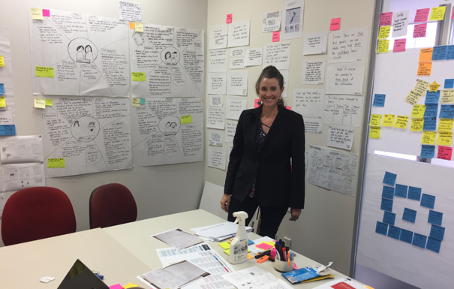Tracking the experience of parents as their child moves through the education system
The Lab acted as a kind of petri dish - co-location of diverse agencies increased opportunities for cross-pollination and sometimes even created new synergies. One of the Lab’s unique approaches /ways of working was to offer free space, when possible, to agencies who just needed somewhere to work. The only cost was they had to have ‘a conversation’ with Lab staff when asked - to share their work with a view to uncovering areas of where either could contribute to the work, knowledge or learning of the other.
Brief description of the Ministry Of Education (MOE) project:
Tracking the experience of parents as their child moves through the education system from New Entrant (age 5) to the end of their Primary years (approx.. age 12)
What happened:
A small group of MOE staff, captained by Service Designer Megan Williams, came in to work part-time in a small room for two weeks because they lacked space at their head office. The team grew and it stayed nearly six months in the end. Why? The power of a neutral space for multiple government agency teams to work in meant the MOE team could sit and discuss ideas alongside Life Events, Ministry of Health (MOH), and any number of other teams that were moving through the shared space. The work by each of these teams provided more context and content that could inform the work that Megan’s team was discussing. Thus, the life journey map the MOE team were creating was done alongside existing work, and as a consequence was a much richer and more useful piece of work.
The power of…..
- Neutral space for multiple agencies to work in, away from BAU pressures and ‘mind-ruts’.
- Serendipity – co-locating agencies who don’t have obvious links.
- Opening the door to start investing in enduring relationships that may pay dividends quickly or further in the future. (Trusted relationships are fundamental to almost all the Lab’s progress and successes)
Benefits
Teams across the public sector are using design-thinking methodologies, and tools with human lead approaches – but as long as they remain in their vertical delivery models (MOH, MOE, Ministry of Social Development etc) they will only ever be able to design for a particular subset of the citizen’s experience. To fully deliver better public service, government agencies need spaces that allow them to work collaboratively – not just to meet, but to work together, on understanding how their multiple work streams impact on citizens. In this future state model, individual agencies still own the ability and authority to deliver their respective services, as they are funded; but a neutral, shared space to consider, discuss and design how these services are linked is critical to designing more effective services for all New Zealanders. Another benefit from this approach is that it would enable and lift public sector capacity and capability, and those skills will be developed and further embedded within individual agencies.
Testimonial
“The Lab’s a great place to talk about your work with others in other agencies. People here are like coaches and they think bigger – and across the whole of the government sector, not just one agency. I’ve really enjoyed the cross-pollination that has resulted from that. We’ve been journey mapping an experience for parents along the education system. Someone in the Lab used to be a principal and came and talked with us. He had a lightbulb moment and talked to us about the work he was involved in with another group looking at early childhood education. You feel this is a place where you can do that ‘bigger thinking’, that ‘future-focused’ thinking - it’s really conducive to that.”
Megan Williams, Service Designer, Parents and Community Information group. Ministry of Education


